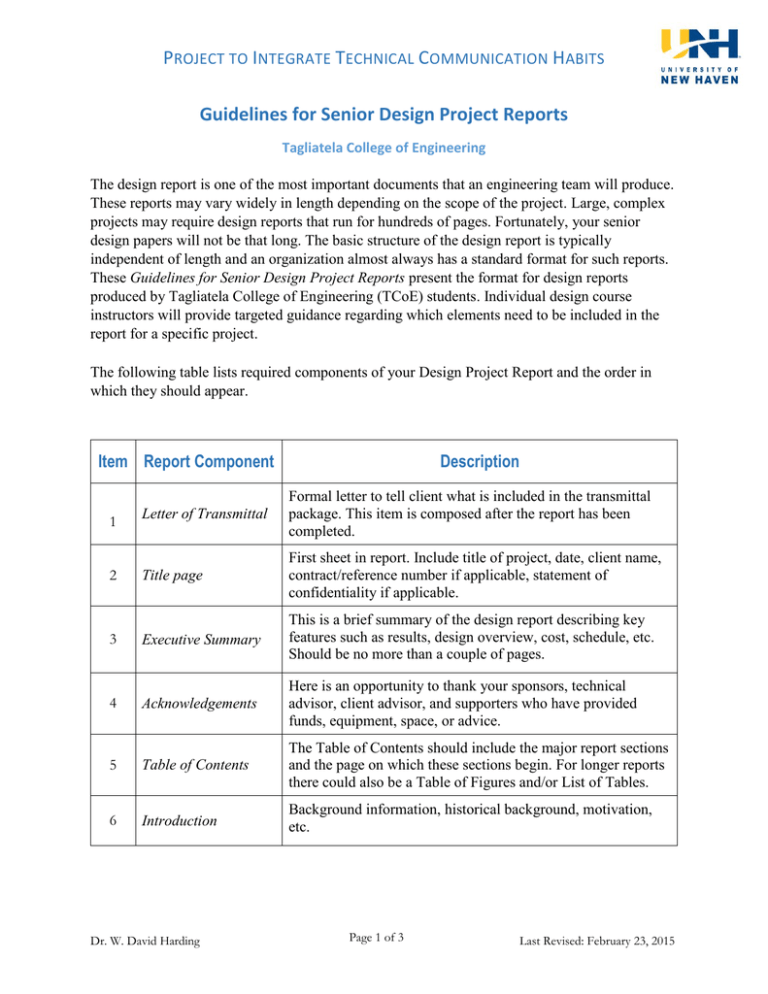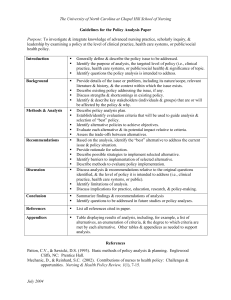Guidelines for Senior Design Project Reports
advertisement

PROJECT TO INTEGRATE TECHNICAL COMMUNICATION HABITS Guidelines for Senior Design Project Reports Tagliatela College of Engineering The design report is one of the most important documents that an engineering team will produce. These reports may vary widely in length depending on the scope of the project. Large, complex projects may require design reports that run for hundreds of pages. Fortunately, your senior design papers will not be that long. The basic structure of the design report is typically independent of length and an organization almost always has a standard format for such reports. These Guidelines for Senior Design Project Reports present the format for design reports produced by Tagliatela College of Engineering (TCoE) students. Individual design course instructors will provide targeted guidance regarding which elements need to be included in the report for a specific project. The following table lists required components of your Design Project Report and the order in which they should appear. Item Report Component Description 1 Letter of Transmittal Formal letter to tell client what is included in the transmittal package. This item is composed after the report has been completed. 2 Title page First sheet in report. Include title of project, date, client name, contract/reference number if applicable, statement of confidentiality if applicable. Executive Summary This is a brief summary of the design report describing key features such as results, design overview, cost, schedule, etc. Should be no more than a couple of pages. 4 Acknowledgements Here is an opportunity to thank your sponsors, technical advisor, client advisor, and supporters who have provided funds, equipment, space, or advice. 5 Table of Contents The Table of Contents should include the major report sections and the page on which these sections begin. For longer reports there could also be a Table of Figures and/or List of Tables. 6 Introduction Background information, historical background, motivation, etc. 3 Dr. W. David Harding Page 1 of 3 Last Revised: February 23, 2015 PROJECT TO INTEGRATE TECHNICAL COMMUNICATION HABITS 7 Problem/Project Definition Statement of the desired outcome or work product (is it a physical product, software product, process design, building/structure design, etc.), definition of the problem or problem statement, design constraints, related work, summary of literature review, summary of patent review. 8 Evaluation of Alternatives Screening level of analysis used to focus the design team on the alternative most likely to succeed. Alternatives not selected can be described in the appendices. 9 Design Approach Description of the components of the design process that the team employed in arriving at the final design. 10 Design Narrative, Design Verification/ Implementation, Performance Evaluation, Testing, etc. Detailed description of the design, design verification/implementation, performance evaluation, system capabilities, documentation. Discussion of testing and verification protocols and the results of testing, whether physical testing or simulation. Details of testing and other topics are typically placed in appendices. 11 Professional and Societal Concerns, Cost and Economic Evaluation Safety concerns and how they will be mitigated, potential environmental impacts of design, potential health impacts (both positive and negative), other societal impacts. Summary of the cost estimation and economic evaluation of the selected design including protocols applied to the economic analysis. Additional details may be appropriate in appendices. 12 Discussion Summary of the entire design process. 13 Conclusions and Recommendations Statement of the project team's conclusion of the best course of action based on the completed design process. Detailed recommendations regarding how best to execute the design. May include recommendations for additional work. References/ Citations Documentation of the verified sources of information that provide background information on which the design is based. Should include the clients request for work, the project team’s proposal, and references to patent literature, standard handbooks, journal articles, textbooks, industry and government standards, and internet based sources. Appendices The appendices provide an opportunity to present additional details that are not critical to the design focus. Items to include here (as appropriate) are Bill of Materials, details of modeling and simulations, details of testing protocols, detailed test results, certification of performance, details of economic analysis, alternatives evaluated but not selected, etc. 14 15 Dr. W. David Harding Page 2 of 3 Last Revised: February 23, 2015 PROJECT TO INTEGRATE TECHNICAL COMMUNICATION HABITS Formatting: Suggested formatting includes the following. Font: Times New Roman 12 pt. Single spacing of text, left justified, skip line between paragraphs. Margins: top and bottom 1.0 in., left and right 1.25 in. Follow format specified by the requestor or your course instructor if different. Figures, tables, equations and listings should be formatted and referenced in the text in accordance with the disciplinary norms or as specified by the requestor or your course instructor. General Advice: A client will judge the overall quality of your work based on your report presentation. If the client finds your report to be disjointed, disorganized, or containing significant composition errors they are likely to doubt your technical analysis. Take great care to make sure these non-technical aspects do not detract from your overall message. Dr. W. David Harding Page 3 of 3 Last Revised: February 23, 2015
